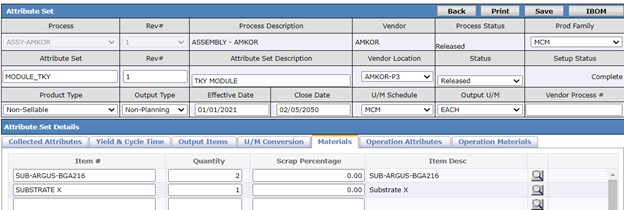Semiconductor manufacturing typically requires a “one-to-many” production process where wafers move to die, and die are then moved through multiple assembly and packing processes to provide multiple outcomes from a single wafer. This is achieved in Tensoft SemiOps through an inverted BOM (Bill of Materials) model. An inverted BOM is an essential feature for systems to efficiently handle semiconductor manufacturing needs, which are poorly served by standard discrete manufacturing processes. Instead, what is required is closer to process manufacturing with services delivered by different suppliers to create multiple end products.
However, there are scenarios where a customer requires a more traditional BOM process. Tensoft SemiOps also supports this “many-to-one” BOM model, where multiple parts go into the creation of one single end product.
For example, if an assembly process requires an additional commodity die or additional substrate to create one assembled die, that would look more like the many-to-one process typically handled with a traditional BOM. Tensoft SemiOps supports this through its consumed material model.

The consumed material model allows multiple part numbers and quantities to be consumed in a single process step. It also allows you to specify the quantity, so the process step can consume multiple die from your production flow if necessary.
The IBOM model assumes that the output of one step is the input to the next sequential step. For example, assembled die are the input into the final test process. BOM processes can be merged into the IBOM flow when you have more than one die in an assembly package or other configurations where you need to add material on top of your IBOM process flow.
If you would like to learn more about Tensoft SemiOps, visit our website or contact us today!
Related Blog Posts: